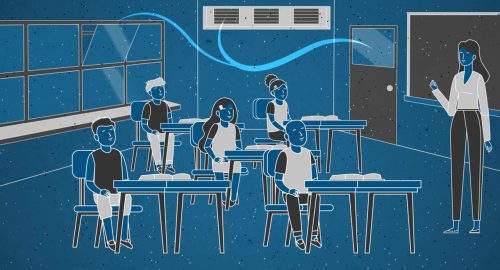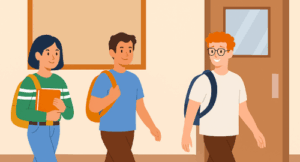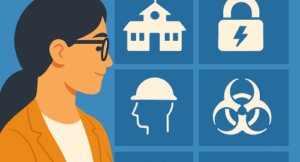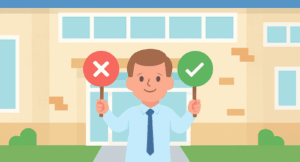This article originally appeared on The Wall Street Journal. To view the original article, click here.
Written by Julie Jargon | Photo illustration: Laura Kammermann | Aug. 11, 2020
Coronavirus touches off a wave of school spending on tracking technology but how will it be used when the pandemic ends?
When students return to school this fall, things are going to look different and not just because everyone will be wearing masks.
Some students will walk past thermal-imaging cameras that take their temperature; some will wear beacons that trace their movements around campus. Other changes will be more subtle, such as security cameras that detect when students have removed their masks or are standing too close together.
The coronavirus pandemic has started a wave of surveillance technology aimed at helping schools prevent or contain infection. All this tech raises big questions that dont have clear answers. Will it work? Could it create a false sense of security? And how will these measures be used after the pandemic ends?
Some of the new technology leverages schools existing security systems. Motorola Solutions whose security and communications systems are already installed in thousands of schools around the country has developed artificial intelligence compatible with its existing cameras to recognize when an individual isnt wearing a mask.
We used data that weve collected over months of different types of face masks, and we’ve trained a neural network to tell when they have those types of masks on their faces or not, Mahesh Saptharishi, Motorola Solutions chief technology officer, said.
The cameras also can detect how far apart people are. If children were spotted less than 6 feet apart for a period of time designated as worrisome, that instance could be logged and could even trigger an alert to school staff.
Perry Township Schools, in Indianapolis, is planning to use the system to enforce safe social distancing. Weve gone to great lengths to organize kids into cohorts and to keep them moving they wont be using lockers during the day and this will help us identify areas where kids are hanging out too long, said Chris Sampson, the districts associate superintendent.
Dr. Saptharishi said Motorola Solutions also offers software that can assist schools in contact tracing. The software doesn’t use facial recognition, but detects physical attributes such as a persons height or shirt color, enabling school officials to quickly review video to trace movements and contacts of a student who reported testing positive for Covid-19.
If this all sounds rather Orwellian, thats because it is, and it has privacy experts concerned about the potential for misuse.
Often when measures are introduced for a specific purpose, they linger on because people become acclimated, said Ryan Calo, a law professor at the University of Washington, in Seattle. Many U.S. schools were already getting heavily into surveillance technology before the pandemic, he said. When these technologies are no longer needed to detect fever or conduct contact tracing, will they all the sudden be used to detect truancy?
School shootings have been the impetus for much of the new surveillance tech. Its no longer common to visit a school that isn’t outfitted with cameras and extensive visitor check-in systems, some that scan drivers licenses against sex-offender registries and other persona non grata lists. Many of these security companies are adding Covid-detection features to their systems.
Raptor Technologies, which makes automated visitor and volunteer management systems for schools, has added customizable health-screening questions to its visitor check-in systems, based on guidelines from the Centers for Disease Control and Prevention. Its an honor system, though: To be denied entry, a visitor has to admit to having a fever or Covid-like symptoms.
As schools try to minimize physical contact, many have switched to self-service check-in kiosks and away from having visitors sign in with front desk staff. Raptor has seen greater sales growth for its kiosks in the past six weeks compared with all of 2019, Chief Executive Jim Vesterman said. Approximately 2,400 of its customer’s schools already have turned on the new health-screening feature.
The Brazosport Independent School District in suburban Houston has added health-screening questions to its Raptor visitor check-in system. Separately, it also ordered thermal cameras for 18 of its 20 schools. Not only do the cameras take temperatures of students and visitors, but they also detect when someone isnt wearing a mask. When the pandemic ends, according to Ty Morrow, the districts safety coordinator, the district plans to integrate the cameras into an AI surveillance system it is developing to detect weapons and unauthorized visitors.
Volan Technology, which started out in late 2018 designing emergency response systems for schools and hotels, has also positioned its systems to assist in contact tracing. Students, teachers and staff at schools that have purchased its equipment for contact-tracing purposes will wear badges that communicate wirelessly with geofencing-enabled sensors installed in every room, thus tracking their on-campus movement.
The data is shared with Volans private, encrypted iOS app, which schools can use to look back at the movements of anyone who tests positive to determine exactly where they were, with whom and for how long during a prior 14-day period. The app would assign risk scores to people based on how much time they spent near or in the same room with the infected person, to avoid unnecessary calls from the school nurse.
Volan CEO Michael Bettua said districts have told him they might one day use the beacons to take attendance and keep track of who is on campus. There goes Ferris Buellers day off.





